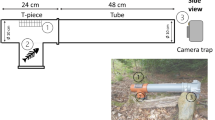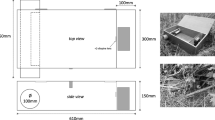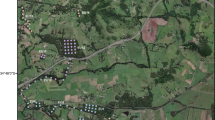Abstract
Camera traps are a valuable tool in wildlife monitoring. Despite their wide use to capture large or medium-sized species, modern techniques also allow them to capture small animals. However, customized cameras, which meet the challenging demands for this purpose during fieldwork, are still quite expensive and require a certain technical know-how. Here we present a way to modify commercial trail cameras to monitor open-nesting songbirds. In particular, we describe how to adjust focus and exposure in order to capture close-up situations of small animals which are very distinct from the default settings when capturing large wildlife. We illustrate the applicability of the modifications from data of a nest predation survey in the Blackcap (Sylvia atricapilla). Compared to pictures from a preliminary study using unmodified trail cameras of the same kind, the pictures were much improved in picture focus and in nocturnal exposure. In addition to improved species identification, the modifications also allowed the cameras to capture more details of life-history events (e.g. of hatching processes and feeding). The manipulation protocol offers a promising and cost-effective approach for nest monitoring as well as for different areas of “close-up” applications to study small endothermic animals.
Zusammenfassung
Anpassungen von Wildkameras für optimiertes Monitoring von freibrütenden Singvögeln
Kamerafallen sind ein wertvolles Hilfsmittel für das Monitoring von Wildtieren. Trotz ihres breiten Einsatzes zur Erfassung großer oder mittelgroßer Arten ermöglichen moderne Techniken auch die Erfassung von kleineren Tieren. Speziell angefertigte Kameras, die den anspruchsvollen Anforderungen für diesen Zweck bei der Feldarbeit gerecht werden, sind jedoch immer noch recht hochpreisig und erfordern ein gewisses technisches Fachwissen. Hier stellen wir eine Möglichkeit vor, handelsübliche Wildkameras so zu modifizieren, dass sie freibrütende Singvögel überwachen können. Insbesondere beschreiben wir, wie Fokus und Belichtung angepasst werden können, um Nahaufnahmen von kleinen Tieren zu machen, die sich von den Standardeinstellungen bei der Aufnahme großer Wildtiere stark unterscheiden. Wir veranschaulichen die Anwendbarkeit der Modifikationen anhand von Daten einer Nestprädationsstudie bei der Mönchsgrasmücke (Sylvia atricapilla). Im Vergleich zu Bildern aus einer Vorstudie mit den gleichen aber nicht modifizierten Kameras waren die Bilder hinsichtlich Bildschärfe und nächtlicher Belichtung deutlich verbessert. Neben der optimierten Artbestimmung erlaubten die Modifikationen den Kameras auch, mehr Details von lebensgeschichtlichen Ereignissen (z. B. von Schlupfprozessen und Fütterungen) zu erfassen. Das Manipulationsprotokoll bietet einen vielversprechenden und kostengünstigen Ansatz für das Monitoring von Nestern sowie für verschiedene Bereiche der „Nahaufnahme “-Anwendungen zur Untersuchung kleiner endothermer Tiere.




Similar content being viewed by others
References
Apps P, McNutt JW (2018) Are camera traps fit for purpose? A rigorous, reproducible and realistic test of camera trap performance. Afr J Ecol 56(4):710–720
Gray EL, Dennis TE, Baker AM (2017) Can remote infrared cameras be used to differentiate small, sympatric mammal species? A case study of the black-tailed dusky antechinus, Antechinus arktos and co-occurring small mammals in southeast Queensland, Australia. PloS One 12(8):e0181592
Hobbs MT, Brehme CS (2017) An improved camera trap for amphibians, reptiles, small mammals, and large invertebrates. PLoS One 12(10):1–15
Kucera TE, Barrett RH (2011) A history of camera trapping. In: O’Connell AF, Nichols JD, Karanth KU (eds) Camera traps in animal ecology. Springer, Tokyo, pp 9–26
Long RA, MacKay P, Zielinski WJ, Ray JC (2008) Noninvasive survey methods for carnivores. Island Press, Washington, DC
Meek PD, Ballard G, Claridge A, Kays R, Moseby K, O’Brien T et al (2014) Recommended guiding principles for reporting on camera trapping research. Biodivers Conserv 23(9):2321–2343
Meek PD, Pittet A (2012) User-based design specifications for the ultimate camera trap for wildlife research. Wildl Res 39(8):649–660
Murphy AJ, Farris ZJ, Karpanty S, Kelly MJ, Miles KA, Ratelolahy F et al (2018) Using camera traps to examine distribution and occupancy trends of ground-dwelling rainforest birds in north-eastern Madagascar. Bird Conserv Int 28(4):567–580
Newey S, Davidson P, Nazir S, Fairhurst G, Verdicchio F, Irvine RJ, van der Wal R (2015) Limitations of recreational camera traps for wildlife management and conservation research: a practitioner’s perspective. Ambio 44:624–635
O’Connell AF, Nichols JD, Karanth KU (2011) Evolution of camera trapping. In: O’Connell AF, Nichols JD, Karanth KU (eds) Camera traps in animal ecology: methods and analysis. pp 1–3
Rovero F, Zimmermann F (2016) Camera trapping for wildlife research. Pelagic Publishing, Exeter
Rovero F, Zimmermann F, Berzi D, Meek P (2013) “Which camera trap type and how many do I need?” A review of camera features and study designs for a range of wildlife research applications. Hystrix 24:9–17
Rowcliffe JM, Carbone C, Jansen PA, Kays R, Kranstauber B (2011) Quantifying the sensitivity of camera traps: an adapted distance sampling approach. Methods Ecol Evol 2(5):464–476
Schaefer T (2002) Adaption an nestprädation bei der mönchsgrasmücke. Georg-August-Universität Göttingen, Dissertation, University of Göttingen
Stille D (2017) Einsatz von Wildkamerafallen zur Erfassung von Kleinsäugern in den Bayerischen Alpen sowie im Alpenvorland. Umwelt Spezial Bayerisches Landesamt für Umwelt, Augsburg
Acknowledgements
We would like to thank Stefan Hannabach for his technical advice and D. Stille for an instruction on his method of camera manipulation. We further thank Simone Bosert, Leona Frieboese, Kathrin Grube und Chloé Vescera for field assistance and in helping to adjust the cameras and to the reviewer for improving the manuscript. J.O.E. received additional funds by a Postdoctoral Fellowship from the Research Foundation—Flanders (FWO; 12G4317N). All experiments mentioned here comply with German law.
Author information
Authors and Affiliations
Contributions
LU and JOE conceived the ideas and designed the methodology, with input from KA and AS. LU led the fieldwork and improved the camera adjustments with support from JOE. LU drafted the manuscript with critical revisions by JOE. All authors contributed to the drafts and gave final approval for publication.
Corresponding author
Ethics declarations
Conflict of interest
The authors declare no conflict of interest. Also, no commercial relationship or interest exist with the camera manufacturer of which cameras where used in this study.
Additional information
Communicated by F. Bairlein.
Publisher's Note
Springer Nature remains neutral with regard to jurisdictional claims in published maps and institutional affiliations.
Electronic supplementary material
Below is the link to the electronic supplementary material.
Rights and permissions
About this article
Cite this article
Uhe, L., Albrecht, K., Schleicher, A. et al. Adjusting trail cameras to improve monitoring of small open cup nesting birds. J Ornithol 161, 893–899 (2020). https://doi.org/10.1007/s10336-020-01758-9
Received:
Revised:
Accepted:
Published:
Issue Date:
DOI: https://doi.org/10.1007/s10336-020-01758-9




